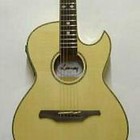
One per cent of the Scottish Borders population is now Polish, so this wee tune takes a sort of polka and a bit of Border and a bit of Scots to welcome them to a climate marginally not so bad as Poland
singer
songwriter
acoustic
folk
british
guitarist
song
celtic
traditional
fingerstyle
scottish
scotland
guitar
kelso
Story behind the song
This is a tune set which has been developing for a year or so, gradually working itself out. It is extremely simple and relies on open string campanella a great deal, in drop D tuning. However, the picking patterns involved are not instinctive and use alternating finger and thumb more than you would expect. The thumb does a lot of work on the high strings in this composition.
The tune is played on a Lamaq small body ultra thin electro acoustic, but it's not even plugged in - and I had to roll the bass off on my twin Behringer C2 mics (about 1 foot from the guitar, crossed stereo config) to avoid too much. And keep the volume down. This inexpensive solid wood all-maple (maple top!) 24.75 inch scale stage guitar has exactly the fast response and clarity of definition I have been looking for to handle this type of playing. It's very easy to play and the cost from iguitars (Antonio Lamaq's eBay shop for his Chinese made instruments) was about the same as buying a hard case from most suppliers. Around a quarter of the real value of the guitar. I regret to say I have now bought four from Mr Lamaq (a well-known classical luthier who has gone to China to get retail steelstrings made) - a jumbo, a small body, this stage guitar and a resonator. Total cost, rather less than the cheapest Taylor...
The tune title is for the 1 per cent of Scottish Borderers who are now Polish, or the other way round :-)
Lyrics
This is an instrumental, so no lyrics, but the opening phrase is can be described for players: Tuning DADGBE. Place two fingers - fret the 3rd on the B string, 5th on the D string - xxx530. Play strings 2-1-2-3 as eight-notes. Next position: move the two finger shape down one set of string, up two frets - xx570x. Play strings 2-3-2-4 as eight notes. Next position: fret strings 4 and 5 at the 7th fret: x770xx. Play 3-4-3-5 as eight notes then end on open string 4 D. That's the opening campanella phrase. It is followed by a partial D7th shape with hammer-on scale - 00421x - then a regular ole G-chord. The second motif uses a 1st position C, the alternate theme a D, the second alternate theme a G (all 1st position) and the harmonic bit is entirely octave harmonics no clever stuff.
You can watch a video of me playing a shortened version (on a very shortened guitar!) on YouTube:
http://www.youtube.com/watch?v=7GXZW_P8V3c